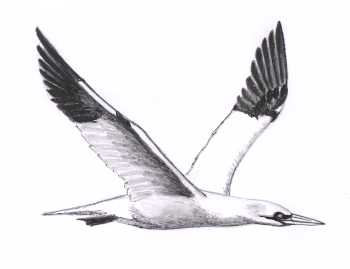
Dear Bird Folks:
Last week I read in the paper that 18,000 gannets were seen in Eastham, with another 20,000 seen in Provincetown. I have lived on Cape Cod for years but I’ve never seen a gannet. Yet, according to the paper there are thousands of them around here. How could I not be seeing these birds?
– Phil, E. Harwich.
Yeah Phil,
I can see how you would miss them. Gannets are huge, bright white seabirds that live out in the open and are nearly the size of a Bald Eagle. Gannets are easy to overlook when there are only 38,000 of them. Perhaps looking up would help.
First of all, gannets are not seen “in” Eastham or “in” Provincetown. They are seen from the beaches of those towns or from most beaches on Cape Cod. Secondly, gannets are most common during fall and spring storms. Since most of us stay inside and watch Oprah during bad weather, we miss some real good stuff. The strong winds that cause flooding high tides, make the beach a tough spot to visit, but a wonderful place to see many birds that are often far out to sea. Also, from a distance gannets look a bit like gulls, so with the driving rain and wind blown sand, most people would simply think they are seeing a flock of gulls and head home to dry off and watch Oprah.
When conditions are bad, the best way to identify gannets is by their feeding behavior, which is unlike any bird you are likely to see off the beaches of Cape Cod. A gannet feeds by flying high into the air, then suddenly diving towards the sea, slowly collapsing it’s wings as it approaches the water. The giant bird now becomes almost spear-like, hitting the water face first at great speeds. Gannets can dive from heights of up to 300 feet. To give you an idea how far 300 feet is, imagine the length of a football field or the length of the line at the Registry of Motor Vehicles, on a good day.
To help cushion the shock of smacking the water, gannets have sacs in their chest that they inflate with air just before they hit the water. Hmm, an inflatable chest. I think I saw an ad for one of those in the back of a magazine a while ago. So that’s what they are for.
Once below the surface the gannet uses its powerful webbed feet to propel it through the water in pursuit of a fish dinner. When the bird swims back up to the surface, it must take flight, gain altitude and drive itself deep into the water to once again look for fish. Keeping that thought in mind, try to imagine 20,000 gannets taking off, climbing, diving and splashing down continuously, all while a storm is raging all around them. It really does make for one of the most dramatic spectacles in all of nature. For my money, the two most amazing sights in the bird world are feeding gannets and that duck that sells insurance.
You would think a storm would be a tough time for birds to find food, and for many birds it is, but a gannet needs wind to support its unique feeding style. On calm days gannets struggle to take off. Sometimes they are found washed ashore by a heavy surf when there is no wind to help them fly.
Although there are some gannets that winter along our coast, most of them are headed south. However, they will be passing this way again in April. So watch the weather, Phil, if we get a surprise spring Nor’ Easter, pack up and head towards any bay beach. You too might be treated to a magnificent gannet show. Don’t worry about Oprah, you can always set your VCR.